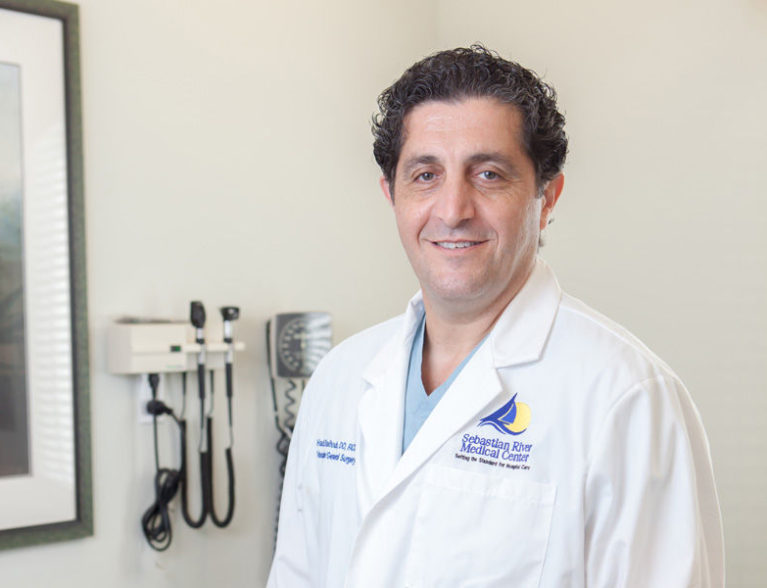
Approximately 17 million Americans, mostly over the age of 65, suffer from peripheral artery disease. Here on the Treasure Coast, Dr. Hadi Shalhoub, vascular and endovascular surgeon at Advanced Surgical Associates and the Sebastian River Medical Center says, “We see it every day. Every day. You’d be surprised how many people around you suffer from peripheral artery disease or PAD.”
In the simplest of terms, PAD is the narrowing or “occlusion” of blood vessels caused by the accumulation of plaque on the interior walls of the arteries. It is most commonly seen in the legs, thighs and pelvis. PAD restricts the flow of oxygen-rich blood causing leg pain on even the shortest of walks and, if left untreated, can lead to still more severe pain, near-complete immobility, non-healing wounds and eventually to the amputation of the affected limb.
Peripheral artery disease can also be a telltale sign of more widespread plaque accumulation throughout the arterial system (atherosclerosis) which can lead to both heart attack and stroke.
Together with Rick Walters, director of cardiovascular services at both Sebastian River Medical Center and Vero Beach’s Heart Center of the Treasure Coast and a registered cardiovascular interventional specialist, Shalhoub broke new ground in the treatment of PAD in early April of this year.
On April 2, Shalhoub became the first surgeon in Indian River and Brevard counties to employ a brand new product, only approved by Medicare the previous day, along with a standard technique called an “atherectomy” in a PAD procedure. (An atherectomy is the removal of plaque from within a blood vessel using a small tube or catheter fitted with a cutting blade or grinding burr: a kind of arterial Roto-Rooter.)
The new product? Drug-coated angioplasty balloons.
Traditional angioplasty balloons have been used to treat PAD since 1964 but these new balloons, made by Medtronic, aim to change the previous procedure altogether.
Here’s how: Until now, angioplasty balloons were used to widen blocked arteries and metal stents or small, flexible wire mesh tubes were inserted into the artery at the same time. The stent or mesh expanded when the balloon was inflated and when the balloon was deflated the metal mesh was left in place to help keep the artery open.
Unfortunately, a combination of scar tissue developing inside the artery wall as a result of normal tissue trauma brought on by the foreign mesh and the re-accumulation of plaque often caused the recently widened artery to quickly start to narrow again. This is called “restenosis” and the result of that restenosis was that the entire angioplasty and stent procedure would frequently have to be repeated just six to 12 months later.
Since the arteries in the leg are so long, removing and replacing mesh stents that can be more than 20 centimeters long (seven-to-eight inches) was becoming problematic.
That’s where Medtronic’s new angioplasty balloons come into play.
These new balloons are pre-coated with the anti-restenotic drug, paclitaxel, along with another agent that helps the paclitaxel be absorbed into the artery wall. The paclitaxel not only helps prevent more plaque from forming inside the artery wall, it also fights the scaring that occurs naturally when any foreign object is inserted inside the blood vessels.
As these new balloons are inflated, the paclitaxel is transferred to and absorbed by the artery walls. The balloon is then delated and removed with only the drug left behind, and the newly re-opened artery enables restored blood flow throughout the lower extremities.
According to Walters, “All kinds of micro-fissures along the blood vessel (used to) appear in the normal healing process. The drug-coated balloons prevent that.”
Shalhoub puts it even more simply. “These new medication-coated balloons,” says the fellowship-trained vascular surgeon, “are the wave of the future.”
While the Medtronic balloons have only recently been approved by both the Federal Drug Administration, (December of 2104), and Medicare, (April of 2015), clinical tests prior to those approvals provided some impressive results.
Over 3,500 patients worldwide were monitored during clinical trials and, “only 2.4 percent of patients required a repeat procedure within one year compared to 20.6 percent” with the traditional procedure.
Since Shalhoub claims that, “probably more than 30 to 40 percent” of the U.S. population suffers from or will suffer from PAD, the new drug-coated angioplasty balloons appear to be a potentially impressive improvement.
As with any new product or procedure, Shalhoub and Walters will be closely monitoring patients receiving this new PAD treatment. (No additional incisions will be required as the monitoring will be done using ultrasound scans.)
Walters, meanwhile, adds that, “So far we’re the only ones in Indian River County who have this procedure,” but adds that he expects others to embrace the new technique sooner or later.
According to the Mayo Clinic, symptoms of PAD may include painful cramping in the hip, thigh or calf muscles when walking or climbing stairs; numbness or weakness in the leg; sores on the toes, feet or legs that won’t heal; a change in the color of legs; a weak pulse in the legs or feet and even erectile dysfunction in men. Pain may even occur while resting or lying down and can even prevent or disrupt sleep in severe cases. If you experience any of those symptoms, consult your primary care physician.
Dr. Hadi Shalhoub is with Advanced Surgical Associates and the Sebastian River Medical Center in Sebastian, FL. His number is 772-581-8900. Rick Walters is with Sebastian River Medical Center and Vero Beach’s Heart Center of the Treasure Coast. His number is 772-388-4306.



